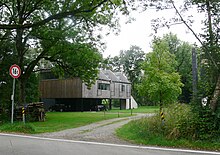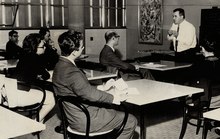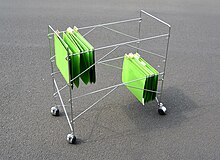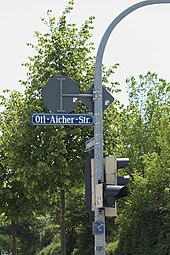Otl Aicher
Otto "Otl" Aicher (* 13. May 1922 in Ulm , † 1. September 1991 in Gunzburg ) was one of the most influential German designers and graphic designers of the 20th century. Together with his wife Inge Aicher-Scholl , the sister of Hans and Sophie Scholl , and the architect and artist Max Bill , he founded the Ulm School of Design (HfG) in 1953 .
Life
Otl Aicher grew up in an environment that was critical of the Nazi regime . He was a school friend of Werner Scholl; From autumn 1939 he came into closer contact with his siblings; this is how the friendship with the Scholl siblings developed . He was a determined young Catholic who tried to live his life according to the standards of Augustine . Aicher refused to join the Hitler Youth , so he was imprisoned in 1937 and was not allowed to take the Abitur exam in 1941 (after the war he was awarded the Abitur retrospectively).
Nevertheless, when he was drafted into the Wehrmacht in the same year, he received the offer of an officer career , which he refused. He consequently closed himself off from any opportunity for advancement in the military. Due to a self-inflicted injury, he was able to evade military service for a while and stood by the Scholl family in 1943 when Hans and Sophie were convicted and executed for their membership in the White Rose . At the beginning of 1945 Aicher deserted and hid with the Scholls at the Bruderhof in Ewattingen .
In 1946 he began studying sculpture at the Academy of Fine Arts in Munich . The following year he opened his own atelier in Ulm .
Together with his future wife Inge Scholl , the eldest sister of Hans and Sophie, he co-founded the Ulm Adult Education Center in 1946 , for which he designed numerous posters up until the 1960s. With Max Bill and Inge Scholl, he had been doing theoretical and conceptual preparatory work for their own college for design since the late 1940s , which was realized in 1953 with the laying of the foundation stone on Kuhberg in Ulm. He became a lecturer in visual communication .
In 1952 Otl Aicher married Inge Scholl. There were five children from the marriage: Eva Aicher (* 1953), Florian Aicher (* 1954), Pia Aicher (1954–1975), Julian Aicher (* 1958) and Manuel Aicher (* 1960).
In 1956, after Max Bill's resignation , he became a member of a rectorate board of the Hochschule für Gestaltung before becoming its sole rector from 1962 to 1964. He also held visiting professorships in Yale and Rio de Janeiro .
From 1967 to 1972 Aicher was the design commissioner for the Olympic Games in Munich , for which he developed a system of pictograms that is still widely used internationally as a guide.
Atelier in Rotis

Subsequently, Otl Aicher bought a farm with a mill in Rotis (today a district of Leutkirch im Allgäu ) and moved with his family. Here he designed and built several studio houses for his office community in the 1970s . In 1984 he and his wife founded the Institute for Analog Studies in Rotis. There he developed the Rotis typeface family in 1988 , which he named after his place of residence, published his typefaces on design and held specialist seminars . Rotis, which the architect Norman Foster called the "temple", was a forum for Otl Aicher, a platform for work meetings, presentations and courses with colleagues and students. Technical seminars are still held at the institute today.
He was an important mentor for Arch + magazine .
Otl Aicher died on September 1, 1991 as a result of a traffic accident.
Life's work

Aicher is one of the pioneers of corporate design : This is how the visual appearance of Lufthansa was created at the Ulm School of Design , which is still used today in a slight modification. For the Olympic Games in Munich he defined consistent design guidelines that ranged from the uniform to the admission ticket. With its radically reduced pictograms, Otl Aicher's team invented a new sign language that everyone understood immediately. Other companies in whose appearance Aicher was involved are ZDF , ERCO Leuchten , FSB , Frankfurt Airport , Dresdner Bank , Westdeutsche Landesbank , Sparkasse , Raiffeisenbank , Bulthaup Küchen , Bayerische Rück , Durst Phototechnik , Braun , the Bundeswehr , Schulz Bürozentrum and the Severin & Siedler publishing house . He also designed the logo of the University of Konstanz . The term " visual communication" used today can be traced back to Aicher's theoretical work.
Otl Aicher's work had a major impact on the appearance of West Germany in the post-war period. It stands for the optical “purification” of German design and German companies (e.g. Lufthansa ) after the war. His consistent stance towards National Socialism and his friendship with the Scholl family also play a role. In Ulm, where Aicher and others founded the Hochschule für Gestaltung , the first mayor after the war from 1945 to 1949 was Robert Scholl , the father of the Scholl siblings , who became Aicher's father-in-law in 1952.
In his work, Aicher also referred to great role models and existing ideas. His (later failed) attempt to integrate the Swiss artist Max Bill into the Ulm University of Design ran in parallel with a content based on his graphic and typographical doctrines (layout grid, flutter replacement , sans serif fonts, radical lower case ).
For his work, Otl Aicher used typefaces submitted by other typographers, so u. a. the Univers by Adrian Frutiger for the Olympic Games in Munich . Only towards the end of his career did he develop a successful font himself. He called it Rotis after his place of residence in the Allgäu . As a body text it is not perceived as optimal in every respect, but it has been successful with brand logos to this day. a. at the kitchen manufacturer Bulthaup .
Honors
In the summer of 2006, the school conference and the municipal council of the city of Leutkirch decided to name the secondary school Leutkirch "Otl-Aicher-Realschule" in future.
In the course of the Design Parcours Munich 2008 the project “Munich needs an Otl-Aicher-Straße” was started. Aicher is to be honored as a communication designer and, not least, for his achievements as design representative for the 1972 Olympic Games in Munich. By founding an association, the initiators wanted to get a street named after the important designer. On May 6, 2010, the Munich city council complied. Since then there has been an Otl-Aicher-Strasse in the 12 Schwabing-Freimann district .
On the occasion of the 40th anniversary of the 1972 Summer Olympics in Munich, an exhibition entitled “Otl Aicher - Design Olympia 72” took place from July to September 2012 at the Gasteig adult education center there . It showed posters, printed matter and objects that Otl Aicher had developed with his team from 1967 to 1972.
A tram car of the Ulm tram bears his name, as does the “Otl-Aicher-Allee” street in the Lettenwald district of Ulm.
Works (selection)
- The kitchen for cooking . Callwey Verlag, Munich 1982, ISBN 3-936896-18-6
- go in the desert . Frankfurt 1982, ISBN 3-10-000430-2
- Criticism of the car - Difficult defense of the car against its worshipers . Callwey Verlag, Munich 1984, ISBN 3-7667-0747-7
- inside the war . S. Fischer, Frankfurt am Main 1985, ISBN 3-596-13795-0
- typography . Berlin 1988, ISBN 3-87439-683-5 , 1989 2nd A., ISBN 3-433-02090-6 . 256 p. With contribution by Josef Rommen.
- typography . Reprint of the original edition. Hermann Schmidt, Mainz 2005. ISBN 978-3-87439-683-7
- About the color . Hatje Verlag, 1993
- Architecture of making . In: ARCH +, 1990, 102, pp. 29-36
- analog and digital . Berlin 1991, ISBN 3-433-02176-7
- the world as a design . Verlag Ernst & Sohn, 1991, ISBN 3-433-02185-6
- write and contradict . Janus Press, 1993, ISBN 3-928942-03-4 .
- Books published by Otl Aicher with others
- with Rudolf Saß: aerial view Germany . Praesentverlag, Gütersloh 1968
- with Rudolf Saß: In flight over Europe . Otto Müller Verlag, Salzburg 1980
- with Martin Krampen: Sign systems . Alexander Koch Verlag, Munich 1980, ISBN 3-433-02650-5
- with Gabriele Greindl and Wilhelm Vossenkuhl: Wilhelm von Ockham. The risk of thinking in a modern way (Bayerische Rück exhibition series "Explorations"; Exhibition No. 5). Callwey Verlag, Munich 1986, ISBN 3-7667-0804-X
- Günter Behnisch et al .: Constructive intelligence . In: ARCH +, 1990, 102, pp. 42-52
- Books for or from the handle manufacturer FSB
- Otl Aicher and Robert Kuhn: gripping and gripping . Verlag der Buchhandlung Walther König, Cologne. 2nd edition 1995
- Otl Aicher and Jürgen W. Braun: Doorknobs . Workshop in Brakel. Verlag der Buchhandlung Walther König. 1987
- Otl Aicher and Jürgen W. Braun: Johannes Potente, Brakel. 50s design . Verlag der Buchhandlung Walther König. 1989
- Otl Aicher and Jürgen W. Braun: Entrances - Exits . 2nd volume. Verlag der Buchhandlung Walther König, Cologne. 1990
literature
Literature with references to Otl Aicher:
- Norman Foster : Otl Aicher 1991. In: David Jenkins (ed.): On Foster ... Foster On , Munich: Prestel, 2000, pp. 592-595, ISBN 3-7913-2405-5
- Christian Gänshirt: A theory of design? On the writings of Otl Aicher / A Theory of Design? On the Writings of Otl Aicher. In: Design Science in Architecture. Graz Architecture Magazine No. 02, Vienna, New York: Springer, 2005, pp. 174–191
- Herbert Lindinger (Ed.): The morality of objects . Exhibition catalog, Ulm School of Design, Berlin 1987, ISBN 3-433-02272-0 .
- Eva Moser: Otl Aicher: Designer. A biography. Hatje Cantz Verlag, Ostfildern 2011, ISBN 978-3-7757-3201-7 .
- Frank Raberg : Biographical Lexicon for Ulm and Neu-Ulm 1802-2009 . Süddeutsche Verlagsgesellschaft im Jan Thorbecke Verlag, Ostfildern 2010, ISBN 978-3-7995-8040-3 , p. 9 f .
- Markus Rathgeb: The early work of Otl Aicher . In: Baseline # 31, 2001
- Markus Rathgeb: Otl Aicher - Design as a method of action . PhD thesis at The University of Reading, 2001
- Markus Rathgeb: Otl Aicher . Phaidon Press, 2006, ISBN 0-7148-4396-2 . (Monograph)
- Matthias Rugel: Why was she a resistance fighter and I was a designer? The roots of Otl Aicher's design in a discourse with Sophie Scholl , the inner god and medieval rationality . In: Voices of the Time 139th Volume 11, 2014, pp. 723–735.
- Hans and Sophie Scholl : Letters and Notes . (including some letters from Hans and Sophie Scholl to Otl Aicher)
- Nadine Schreiner: From appearance to “corporate design” - contributions to the development process by Otl Aicher . Dissertation, Bergische Universität Wuppertal, 2005
- Nadine Schreiner: The visual appearance of the 1972 Olympic Games in Munich . in: Im Designerpark, ed. K. Buchholz, K. Wolbert, Darmstadt, 2004
- Barbara Schüler: In the spirit of the murdered ... The 'White Rose' and its effect in the post-war period . Schöningh, 2000, ISBN 3-506-76828-X (including on the youth of Otl Aicher in Ulm, on his "biography" inside the war and the beginnings and history of the Ulm vh and the hfg.)
- Eva von Seckendorff: The Ulm School of Design. Foundation (1949–1953) and Max Bill era (1953–1957) ., ISBN 3-922561-81-0
- René Spitz : hfg ulm. the look behind the foreground. the political history of the ulm college for design 1953–1968 . Stuttgart / London 2002. ISBN 3-932565-16-9 . (On the history of the Ulm School of Design from its founding in 1953 to its closure in 1968.)
- Hermann Vinke : The short life of Sophie Scholl . Ravensburger paperback, ISBN 978-3-473-58011-8
- Peter and Angelika Schubert: Otl Aicher, the thinker of the object , film portrait 45 minutes, film No. 3 from edition disegno, Peter Schubert
Web links
- Literature by and about Otl Aicher in the catalog of the German National Library
- Own web presence
- analog and digital - tao tribute to otl
- Aicher's pictograms for the 1972 Olympic Games in Munich , spiegel.de
- Archive of the HFG Ulm
- Web catalog of the Aicher pictograms
Individual evidence
- ^ Markus Rathgeb: Otl Aicher , Phaidon Press, London / New York, 2006; P. 164.
- ↑ Hans-Uli Thierer: 25 years ago a great man from Ulm died: Otl Aicher. In: swp.de. September 1, 2016, accessed October 11, 2017 .
- ↑ Logo of the University of Konstanz . In: University of Konstanz . Retrieved March 4, 2019.
- ^ Otl-Aicher-Strasse . Archived from the original on July 19, 2011. Retrieved July 8, 2012.
- ^ Exhibition: Otl Aicher - Design Olympia 72. ( Memento from August 1, 2012 in the Internet Archive ) In: Münchner Volkshochschule .
- ↑ Andrea Reidt: A designer who sat down between all the chairs. . In: Frankfurter Allgemeine Zeitung , May 9, 2012.
| personal data | |
|---|---|
| SURNAME | Aicher, Otl |
| ALTERNATIVE NAMES | Aicher, Otto (birth name) |
| BRIEF DESCRIPTION | German sculptor, graphic artist, designer |
| DATE OF BIRTH | May 13, 1922 |
| PLACE OF BIRTH | Ulm |
| DATE OF DEATH | September 1, 1991 |
| Place of death | Gunzburg |





